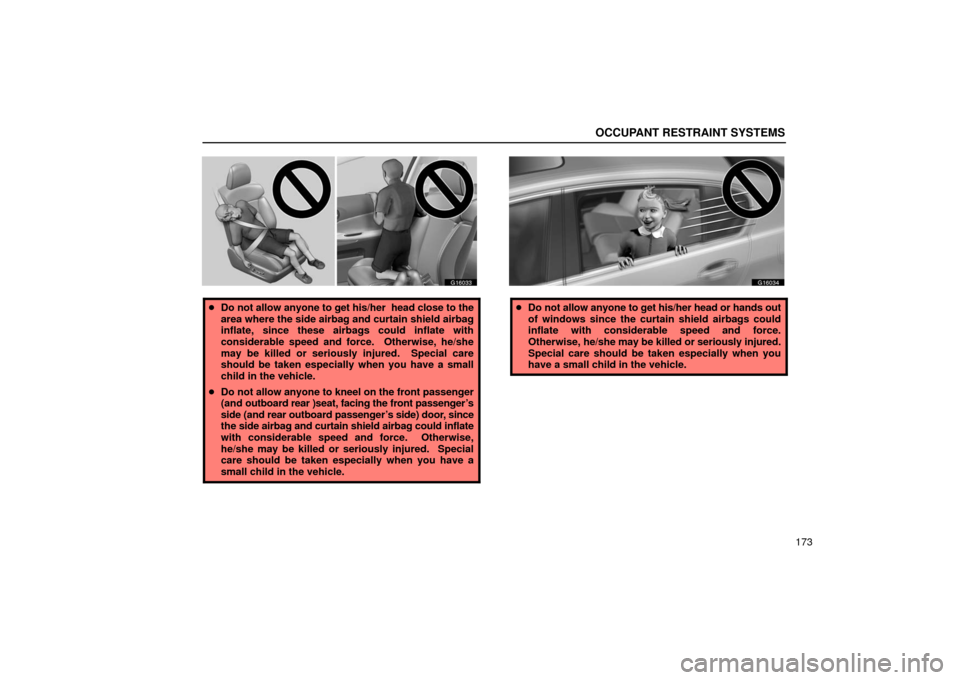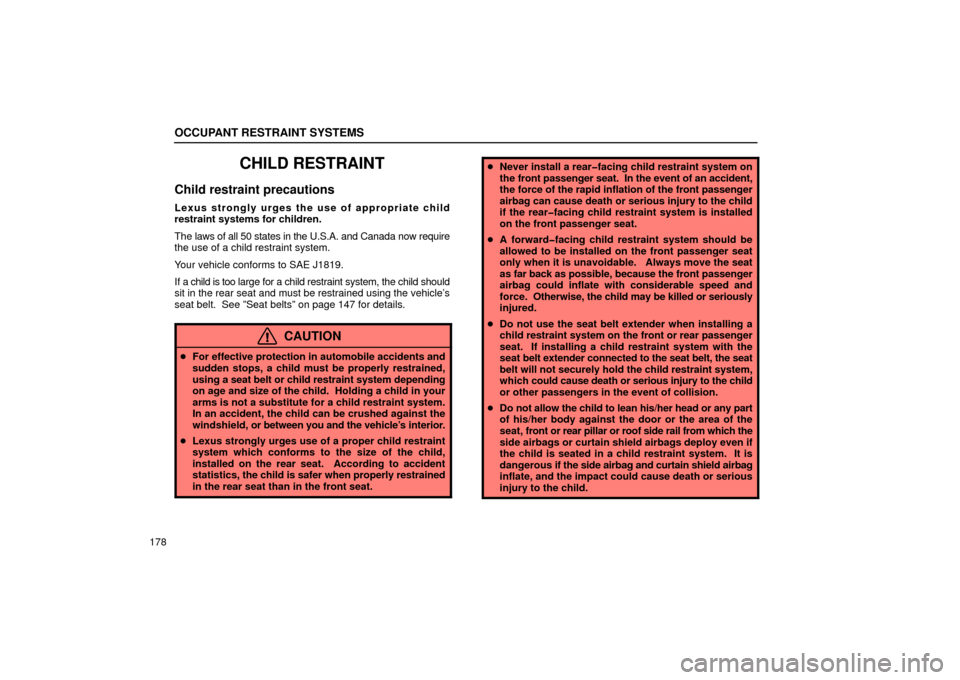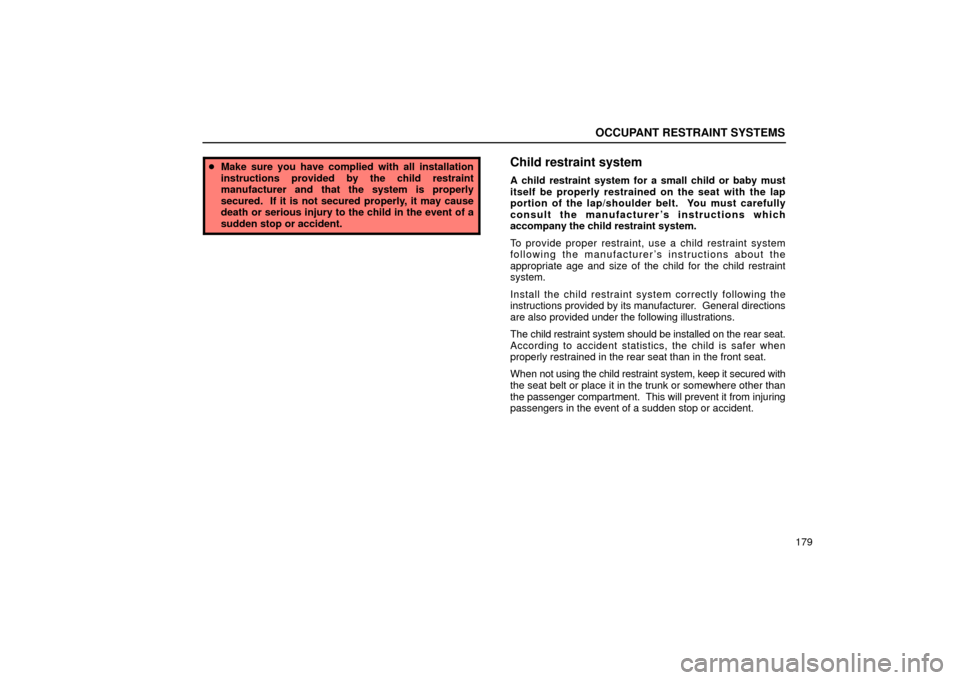Page 194 of 622

OCCUPANT RESTRAINT SYSTEMS
173
G16033
�Do not allow anyone to get his/her head close to the
area where the side airbag and curtain shield airbag
inflate, since these airbags could inflate with
considerable speed and force. Otherwise, he/she
may be killed or seriously injured. Special care
should be taken especially when you have a small
child in the vehicle.
� Do not allow anyone to kneel on the front passenger
(and outboard rear )seat, facing the front passenger’s
side (and rear outboard passenger’s side) door, since
the side airbag and curtain shield airbag could inflate
with considerable speed and force. Otherwise,
he/she may be killed or seriously injured. Special
care should be taken especially when you have a
small child in the vehicle.
G16034
� Do not allow anyone to get his/her head or hands out
of windows since the curtain shield airbags could
inflate with considerable speed and force.
Otherwise, he/she may be killed or seriously injured.
Special care should be taken especially when you
have a small child in the vehicle.
Page 199 of 622

OCCUPANT RESTRAINT SYSTEMS
178
CHILD RESTRAINT
Child restraint precautions
Lexus strongly urges the use of appropriate child
restraint systems for children.
The laws of all 50 states in the U.S.A. and Canada now require
the use of a child restraint system.
Your vehicle conforms to SAE J1819.
If a child is too large for a child restraint system, the child should
sit in the rear seat and must be restrained using the vehicle’s
seat belt. See ”Seat belts” on page 147 for details.
CAUTION
� For effective protection in automobile accidents and
sudden stops, a child must be properly restrained,
using a seat belt or child restraint system depending
on age and size of the child. Holding a child in your
arms is not a substitute for a child restraint system.
In an accident, the child can be crushed against the
windshield, or between you and the vehicle’s interior.
� Lexus strongly urges use of a proper child restraint
system which conforms to the size of the child,
installed on the rear seat. According to accident
statistics, the child is safer when properly restrained
in the rear seat than in the front seat.
� Never install a rear�facing child restraint system on
the front passenger seat. In the event of an accident,
the force of the rapid inflation of the front passenger
airbag can cause death or serious injury to the child
if the rear�facing child restraint system is installed
on the front passenger seat.
� A forward�facing child restraint system should be
allowed to be installed on the front passenger seat
only when it is unavoidable. Always move the seat
as far back as possible, because the front passenger
airbag could inflate with considerable speed and
force. Otherwise, the child may be killed or seriously
injured.
� Do not use the seat belt extender when installing a
child restraint system on the front or rear passenger
seat. If installing a child restraint system with the
seat belt extender connected to the seat belt, the seat
belt will not securely hold the child restraint system,
which could cause death or serious injury to the child
or other passengers in the event of collision.
� Do not allow the child to lean his/her head or any part
of his/her body against the door or the area of the
seat, front or rear pillar or roof side rail from which the
side airbags or curtain shield airbags deploy even if
the child is seated in a child restraint system. It is
dangerous if the side airbag and curtain shield airbag
inflate, and the impact could cause death or serious
injury to the child.
Page 200 of 622

OCCUPANT RESTRAINT SYSTEMS
179
�Make sure you have complied with all installation
instructions provided by the child restraint
manufacturer and that the system is properly
secured. If it is not secured properly, it may cause
death or serious injury to the child in the event of a
sudden stop or accident.Child restraint system
A child restraint system for a small child or baby must
itself be properly restrained on the seat with the lap
portion of the lap/shoulder belt. You must carefully
consult the manufacturer’s instructions which
accompany the child restraint system.
To provide proper restraint, use a child restraint system
following the manufacturer’s instructions about the
appropriate age and size of the child for the child restraint
system.
Install the child restraint s ystem correctly following the
instructions provided by its manufacturer. General directions
are also provided under the following illustrations.
The child restraint system should be installed on the rear seat.
According to accident statistics, the child is safer when
properly restrained in the rear seat than in the front seat.
When not using the child restraint system, keep it secured with
the seat belt or place it in the trunk or somewhere other than
the passenger compartment. This will prevent it from injuring
passengers in the event of a sudden stop or accident.
Page 201 of 622
OCCUPANT RESTRAINT SYSTEMS
180Types of child restraint system
Child
restraint systems are classified into the following 3 types
depending on the child’s age and size.
(A) Infant seat
(B) Convertible seat
(C) Booster seat
Install the child restraint syst em following the instructions
provided by its manufacturer.
Your vehicle has anchor brackets for securing the top strap of
a child restraint system.
For instructions about how to use the anchor bracket, see
“Using a top strap” on page 193.
Child restraint lower anchorages approved for your vehicle
may also be used. See “Installation with child restraint lower
anchorages” on page 195. (A) Infant seat
G16038
(B) Convertible seat
G16039
Page 203 of 622
OCCUPANT RESTRAINT SYSTEMS
182
G16042
CAUTION
�Never install a rear�facing child restraint system on
the front passenger seat. In the event of an accident,
the force of the rapid inflation of the front passenger
airbag can cause death or serious injury to the child
if the rear�facing child restraint system is installed
on the front passenger seat.
G16043
� If the driver’s seat position does not allow sufficient
space for safe installation, install the child restraint
system on the rear right seat.
Page 204 of 622

OCCUPANT RESTRAINT SYSTEMS
183
G16044
1. Run the lap and shoulder belt through or around the infant
seat following the instructions provided by its manufacturer
and insert the tab into the buckle taking care not to twist the
belt. Keep the lap portion of the belt tight.
CAUTION
�After inserting the tab, make sure the tab and buckle
are locked and that the lap and shoulder portions of
the belt are not twisted.
� Do not insert coins, clips, etc. in the buckle as this
may prevent your child from properly latching the tab
and buckle.
� If the seat belt does not function normally, it cannot
protect your child from death or serious injury.
Contact your Lexus dealer immediately. Do not
install the child restraint system on the seat until the
seat belt is fixed.
G16045
2. Fully extend the shoulder belt to put it in the lock mode.
When the belt is then retrac ted even slightly, it cannot be
extended.
To hold the infant seat securely, make sure the belt is in the lock
mode before letting the belt retract.
Page 205 of 622
OCCUPANT RESTRAINT SYSTEMS
184
G16046
3. While pressing the infant seat firmly against the seat
cushion and seatback, let the shoulder belt retract as far as it
will go to hold the infant seat securely.
G16047
CAUTION
Push and pull the child restraint system in different
directions to be sure it is secure. Follow all the
installation instructions provided by its manufacturer.
Page 206 of 622
OCCUPANT RESTRAINT SYSTEMS
185
G16048
4. To remove the infant seat, press the buckle release button
and allow the belt to retract completely. The belt will move
freely again and be ready to work for an adult or older child
passenger.(B) Convertible seat installation
G16039
A convertible seat must be used in forward�facing or
rear�facing
position depending on the age and size of the
child. When installing, follow the manufacturer’s
instructions about the appropriate age and size of the
child as well as directions for installing the child restraint
system.